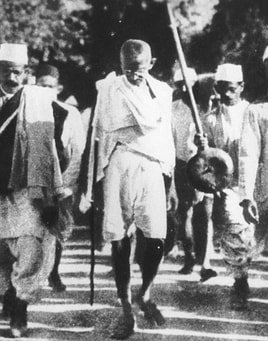Gandhi and Tolstoy
 Who would lead a new Salt March?
Who would lead a new Salt March?
09/20/2020 . I recently read an article about Mahatma Gandhi on the Global Research alt-news website. It was: Truth and Nonviolence, Tolstoy and Gandhi: Light as Darkness Approached By René Wadlow. In it, the author notes the correspondence between Gandhi and Leo Tolstoy in the last couple of years of Tolstoy’s life (1909-1910). It seems they connected over a mutual belief in resisting tyranny through nonviolence on a foundation of personal spiritual values.
Today, thoughts of Gandhi abound among those who realize this current crisis is not about any virus but about the accelerated imposition of a worldwide, technocratic tyranny. Certainly, there is talk of resistance that ranges from civil war to civil disobedience. Gandhi’s methods fell on the side of the latter, of course, but how would they really fare in today’s environment?
As I recall, Gandhi began his formal, nonviolent crusade against British rule with the Salt March. This was a clear violation of the law that prevented people from harvesting salt (from deposits left by ocean surges during the monsoon season), or at least taxed them heavily for it. The law’s result was that people had to buy their salt from the British East India Company, even though India possessed some of the best quality salt deposits in the world.
Gandhi’s salt law disobedience involved a 240 mile long march to the sea to collect his salt. The march was heavily publicized and collected crowds of followers along the way. Of course, Gandhi was arrested at the end of it. Other salt marches were then held, lead by other leaders, in defiance of the law. The British beat and arrested the marchers, but ultimately lost India.
The idea of the protest march was used to great effect by the Civil Rights Movement in the US in the 1960s (Martin Luther King was a great admirer of Gandhi). Disobedience of unjust laws was also adopted as a tactic (sitting in the front of a bus, ignoring “whites only” ordinances, and such).
I found another Gandhi article on Global Researched entitled, Mahatma Gandhi, We Need Your Voice Today! (By John Scales Avery). The article reviews a number of areas where Gandhi’s insights would be helpful today. It begs the question of how Gandhi would handle a protest/revolt today. What would be today’s equivalent of a salt march?
Striking against the slew of unconstitutional mask and social distancing ordinances across the country would likely involve marching through public places not wearing masks and not social distancing. Done over a wide area for an extended time, it would make the point. But surely the march would be infiltrated by establishment agents who commit violence. Government could use the march as an excuse to employ the National Guard. The march could be undermined with the “pandemic card,” where the marchers are vilified for endangering the public health.
I think the establishment has also learned from Gandhi, in its usual, perverse way. So does this mean resistance is futile? Civil disobedience and nonviolent protest won’t work today?
I feel sure Gandhi would stick with his nonviolent methods, though adapted to the current state of tech. (Actually, the “current state of tech” is another matter for consideration in another journal entry). I’m sure Gandhi would work out how to do his protests effectively. The problem I see, though, is that there is no Mahatma Gandhi on the scene now.
The Occupy Wall Street movement made much of being “leaderless.” The idea was to provide no targets for the authorities and it worked, to an extent. But though it left a legacy, the Occupy Movement did not survive. It was wiped out by a coordinated assault made by the same petty tyrants binding us with insane, unconstitutional edicts. No, our resistance needs leaders. It needs a redundancy of leaders. That seems to have been the case for the Indian Independence Movement.
A respected leader with moral credentials, rising from the masses, might be the spark that awakens people to the dangers they face. He or she would need to be willing to commit to an extended campaign, and risk their life in the process. When struck down, they would need to be quickly replaced.
If such a leader arose, would enough of the common people follow him/her, understanding that they are, through non-cooperation, opposing the US government without respect to Republican, Democrat, Liberal, Conservative, etc. The division is Right vs Wrong at a very fundamental level.
Other forces ended the British Raj, though Gandhi’s nonviolent revolt certainly finished it off. And when it ended, there was an Indian governing structure ready to take over. Today, things are less clear-cut. It is unclear if nonviolent resistance could topple the rule of technocratic oligarchs with advanced tech and pervasive engines of propaganda at their disposal (Gandhi would say it could, but would take longer). And if they were toppled, what would replace them? Who would be the leaders to institute a truly representative form of government?
I believe such thoughts darkened the last days of Leo Tolstoy. Whatever hope he found, came in the person of Mahatma Gandhi.
Published on September 20, 2020 06:50
No comments have been added yet.



